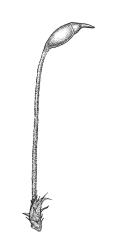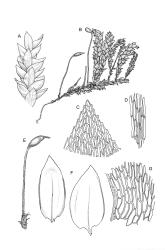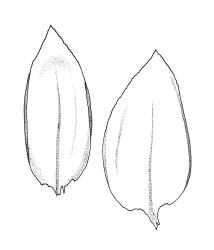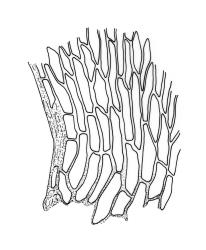Plants medium-sized to robust, yellow- or dark or bright green, weakly lustrous, forming interwoven and sometimes ± pendent mats on irrigated rock. Shoots subjulaceous when fresh. Stems rigid (at least below), irregularly branched, commonly c. 40 mm long, in cross-section with several layers of thick-walled cells surrounding thin-walled cells and a distinct central strand; branches variable in length, scarcely narrowed at apex. Stem and branch leaves not differentiated, broadly ovate, narrowed to the insertion, broadly acute to rounded, weakly homomallous to secund, often eroded, weakly concave and ± striolate when dry, weakly complanate, more concave and variably striolate when moist, not decurrent, c. 1.8–2.1(–2.3) × 1.0–1.3 mm, denticulate in upper half; mid laminal cells linear, mostly (60–)75–87(–115) × c. 6 µm, smooth or very weakly prorate, firm-walled, non-porose; apical cells usually shorter and more rhombic; basal cells (including alar cells) shorter and broader than laminal cells, not forming a distinct group. Costa extending c. ⅔ the leaf length, strongly tapered, becoming thin and obscure above, lacking a terminal spine.
Autoicous. Perichaetia scattered, c. 2 mm long, the inner leaves spreading, acuminate from an oblong-ovate base, ecostate. Perigonia scattered, c. 0.6–1.0 mm long. Setae flexuose, weakly dextrorse above, c. 13–16 mm, orange- to dark brown, coarsely and densely papillose throughout (visible under hand-lens); capsules curved and asymmetric, broadly obovoid, narrowed below mouth when dry, inclined to nearly horizontal, becoming very dark with age, c. 2 mm; exothecial cells mostly oblong, unevenly thick-walled, sometimes appearing weakly collenchymatous; stomata few at capsule base; annulus not differentiated; operculum rostrate from a conic base, c. ⅔ the length of urn. Exostome teeth dark yellow-brown, lanceolate and shouldered, bordered, transversely striate on the outer surface, strongly trabeculate on inner surface, c. 550 µm; endostome from a high membrane, with segments perforate and nearly the height of teeth; cilia single or paired, nodose. Calyptra cucullate, smooth. Spores c. 15–19 µm, green, smooth or nearly so.
Hedenäs 2002, fig. 11 a–b; Seppelt 2004, fig. 34. Seppelt’s illustration shows a plant with much more acuminate leaves than representative N.Z. material.
Confusion might be possible with Brachythecium rutabulum. However, compared to B. rutabulum, the present species is a duller plant, with more wiry stems and undifferentiated stem and branch leaves. None of the leaves in Platyhypnidium austrinum are decurrent, and the alar cells are more compact. There are fairly reliable habitat differences as B. rutabulum does not occur in swiftly flowing water.
NI: N Auckland including offshore islands (GB), S Auckland, Gisborne (Waioeka Gorge, Oronui Stream), Hawke’s Bay (Te Pohue), Taranaki (near Dawson Falls Hostel, Te Maire Scenic Reserve), Wellington, including offshore islands (KA); SI: Nelson, Marlborough, Canterbury, Westland (Jackson Bay), Otago, Southland; St; Ch; A; C. Reported from M by both Hedenäs (2002) and Seppelt (2004).
Australasian. Tasmania*, mainland Australia (N.S.W.*, Vic.*, A.C.T.*).
On rocks in swift streams and in splash zones; either submerged or emergent, and in favourable situations forming mats of several square metres in extent. Collections of this species often bear a dense periphyton of diatoms and sometimes have leaves tattered. Occurring on a wide variety of rock types, including limestone, sandstone, basalt, and granite. The occurrence of this species in a small polluted stream at Charming Creek, Nelson L.D. (A.J. Fife 10450, CHR 515187) suggests this species can tolerate acidic coal-mining effluent. On the North I. from near sea level (North Cape, N Auckland L.D. and Kapiti I., Wellington L.D.) to at least 600 m (Ōhakune, Wellington L.D.), but a W. Martin collection from “near Dawson Falls Hostel” suggests occurrence to at least 800 m elevation. On the South I. from near sea level (Fox River, Nelson L.D. to c. 900 m (Broad Stream, Canterbury L.D.). Frequently associated aquatic species include Cratoneuropsis relaxa, Fissidens rigidulus, Schistidium rivulare, Thamnobryum pandum, and Tridontium tasmanicum.
The unpublished name Hypnum helmsianum was applied by Karl Müller (in herb.) to material of this species collected by Beckett from Waimate (T.W.N. Beckett 152, CHR 585855).











